Content Analysis of IT Service Management (ITECH7400)
VerifiedAdded on 2023/03/17
|21
|4161
|54
Report
AI Summary
This report provides a thorough analysis of IT Service Management (ITSM) and the ITIL framework. It delves into the core components of ITSM, including professional ITSM, IT Infrastructure Library (ITIL), and the ITIL service lifecycle, explaining each stage from service strategy to continual service improvement. The report examines key concepts such as service models, processes, and generic roles within an ITIL structure, alongside an analysis of service lifecycle components like governance and risk management. Furthermore, it explores continual service improvement, business relationship models, service level management, and financial management within the context of IT services. The report also covers essential aspects like business cases, demand management, capacity management, and the seven-step improvement process, including the Deming cycle, to provide a comprehensive understanding of IT service management practices. The analysis is structured to provide a detailed overview of managing services within an organization, making it a valuable resource for students and professionals alike.
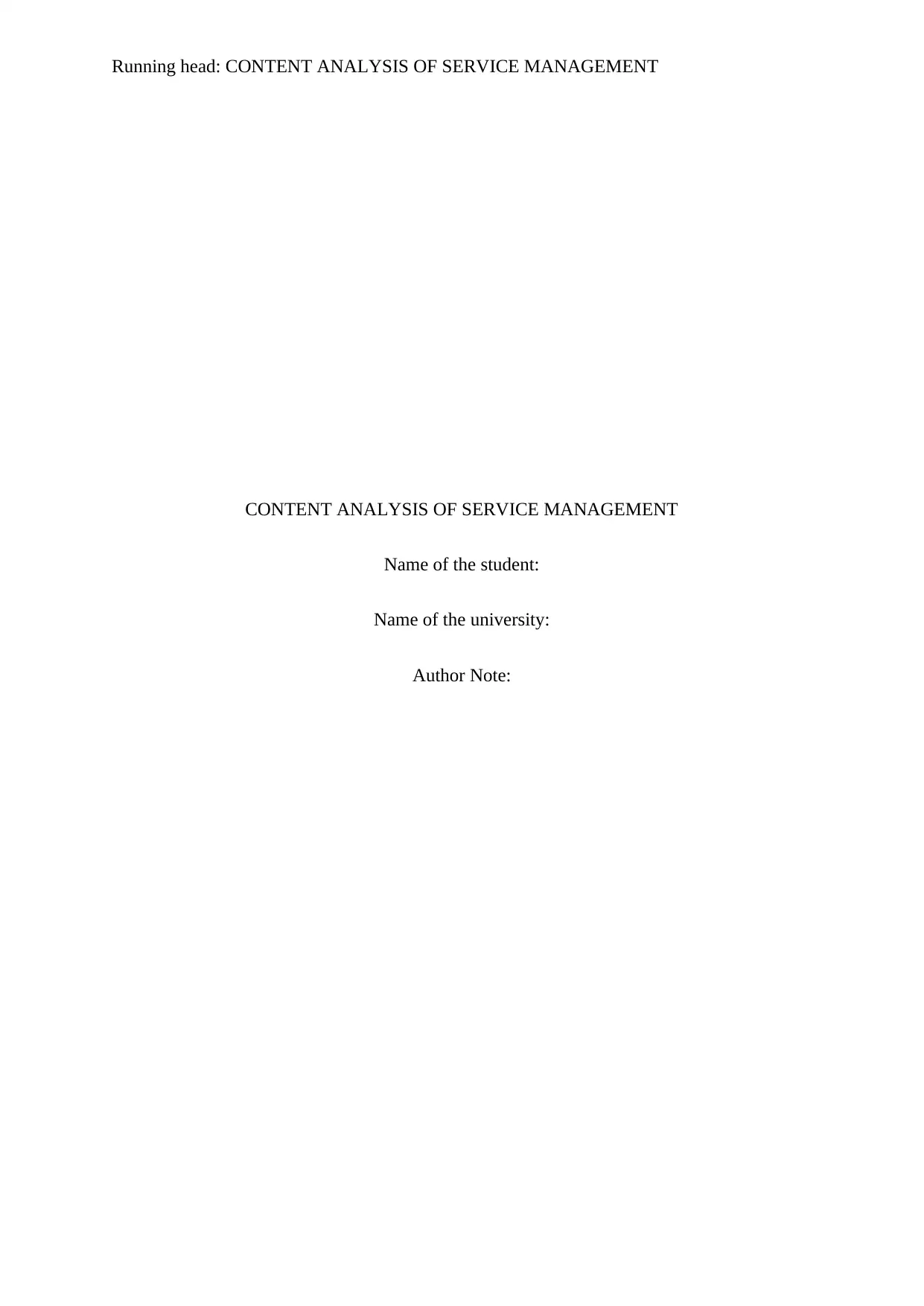
Running head: CONTENT ANALYSIS OF SERVICE MANAGEMENT
CONTENT ANALYSIS OF SERVICE MANAGEMENT
Name of the student:
Name of the university:
Author Note:
CONTENT ANALYSIS OF SERVICE MANAGEMENT
Name of the student:
Name of the university:
Author Note:
Paraphrase This Document
Need a fresh take? Get an instant paraphrase of this document with our AI Paraphraser
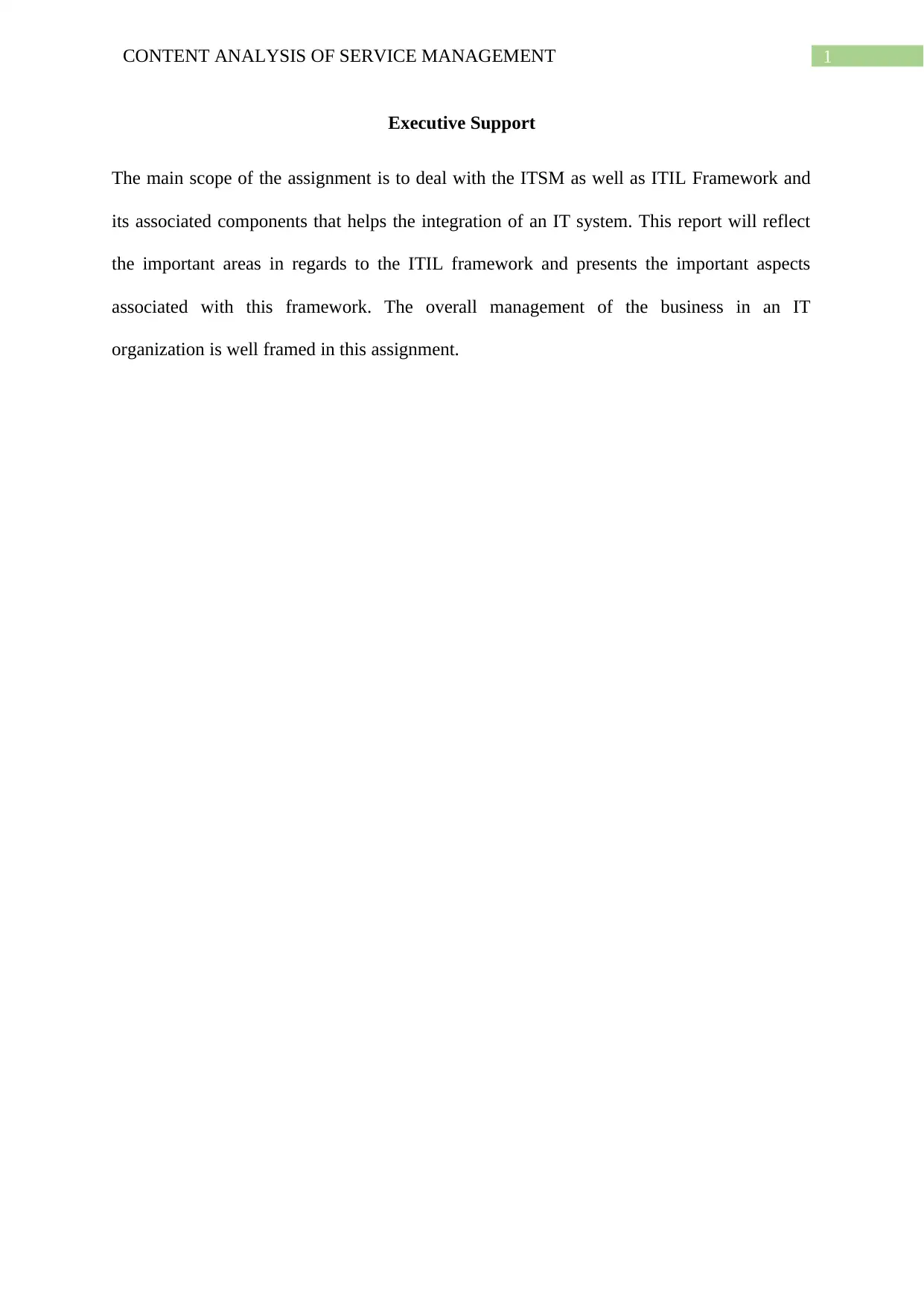
1CONTENT ANALYSIS OF SERVICE MANAGEMENT
Executive Support
The main scope of the assignment is to deal with the ITSM as well as ITIL Framework and
its associated components that helps the integration of an IT system. This report will reflect
the important areas in regards to the ITIL framework and presents the important aspects
associated with this framework. The overall management of the business in an IT
organization is well framed in this assignment.
Executive Support
The main scope of the assignment is to deal with the ITSM as well as ITIL Framework and
its associated components that helps the integration of an IT system. This report will reflect
the important areas in regards to the ITIL framework and presents the important aspects
associated with this framework. The overall management of the business in an IT
organization is well framed in this assignment.
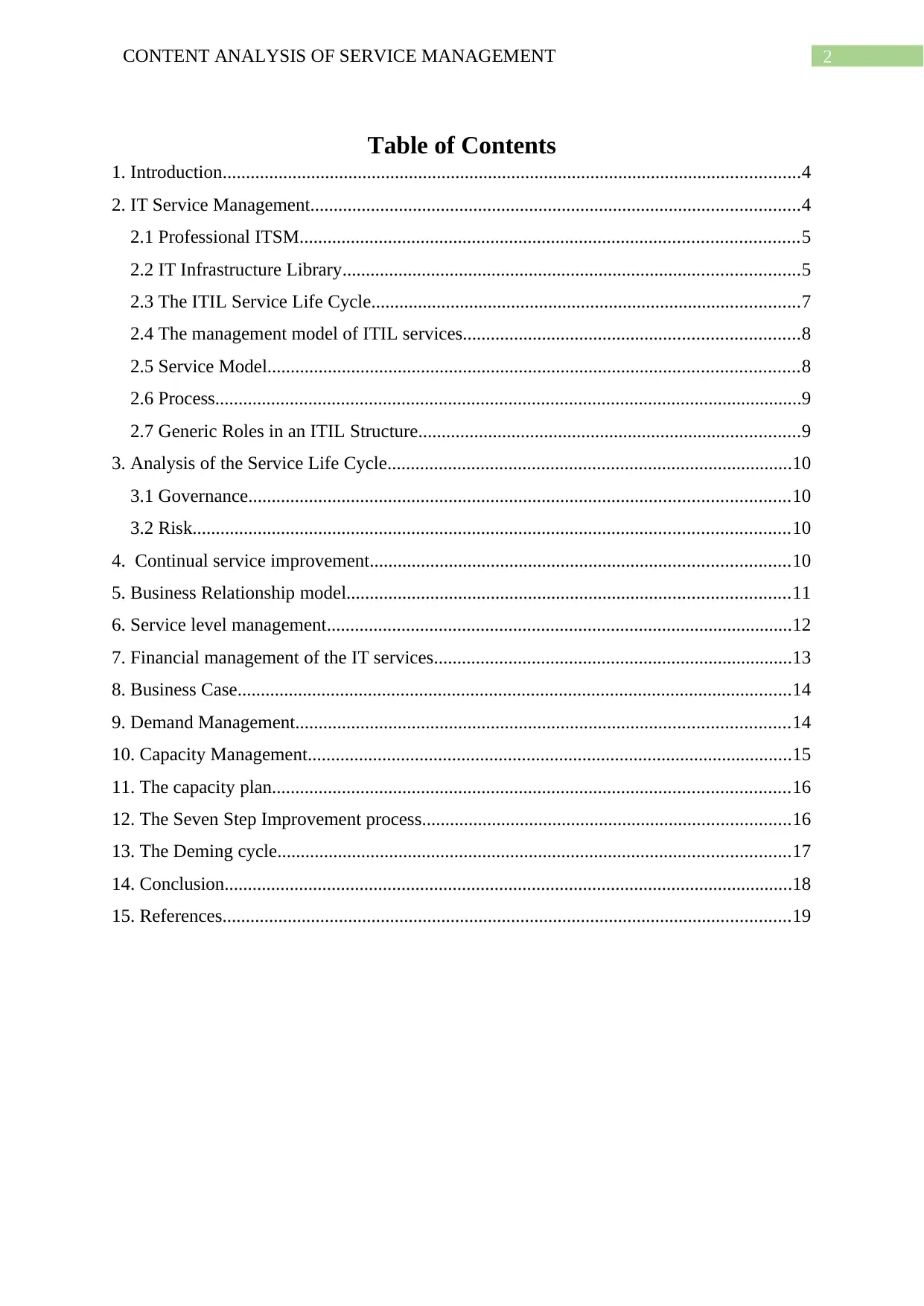
2CONTENT ANALYSIS OF SERVICE MANAGEMENT
Table of Contents
1. Introduction............................................................................................................................4
2. IT Service Management.........................................................................................................4
2.1 Professional ITSM...........................................................................................................5
2.2 IT Infrastructure Library..................................................................................................5
2.3 The ITIL Service Life Cycle............................................................................................7
2.4 The management model of ITIL services........................................................................8
2.5 Service Model..................................................................................................................8
2.6 Process..............................................................................................................................9
2.7 Generic Roles in an ITIL Structure..................................................................................9
3. Analysis of the Service Life Cycle.......................................................................................10
3.1 Governance....................................................................................................................10
3.2 Risk................................................................................................................................10
4. Continual service improvement..........................................................................................10
5. Business Relationship model...............................................................................................11
6. Service level management....................................................................................................12
7. Financial management of the IT services.............................................................................13
8. Business Case.......................................................................................................................14
9. Demand Management..........................................................................................................14
10. Capacity Management........................................................................................................15
11. The capacity plan...............................................................................................................16
12. The Seven Step Improvement process...............................................................................16
13. The Deming cycle..............................................................................................................17
14. Conclusion..........................................................................................................................18
15. References..........................................................................................................................19
Table of Contents
1. Introduction............................................................................................................................4
2. IT Service Management.........................................................................................................4
2.1 Professional ITSM...........................................................................................................5
2.2 IT Infrastructure Library..................................................................................................5
2.3 The ITIL Service Life Cycle............................................................................................7
2.4 The management model of ITIL services........................................................................8
2.5 Service Model..................................................................................................................8
2.6 Process..............................................................................................................................9
2.7 Generic Roles in an ITIL Structure..................................................................................9
3. Analysis of the Service Life Cycle.......................................................................................10
3.1 Governance....................................................................................................................10
3.2 Risk................................................................................................................................10
4. Continual service improvement..........................................................................................10
5. Business Relationship model...............................................................................................11
6. Service level management....................................................................................................12
7. Financial management of the IT services.............................................................................13
8. Business Case.......................................................................................................................14
9. Demand Management..........................................................................................................14
10. Capacity Management........................................................................................................15
11. The capacity plan...............................................................................................................16
12. The Seven Step Improvement process...............................................................................16
13. The Deming cycle..............................................................................................................17
14. Conclusion..........................................................................................................................18
15. References..........................................................................................................................19
⊘ This is a preview!⊘
Do you want full access?
Subscribe today to unlock all pages.

Trusted by 1+ million students worldwide
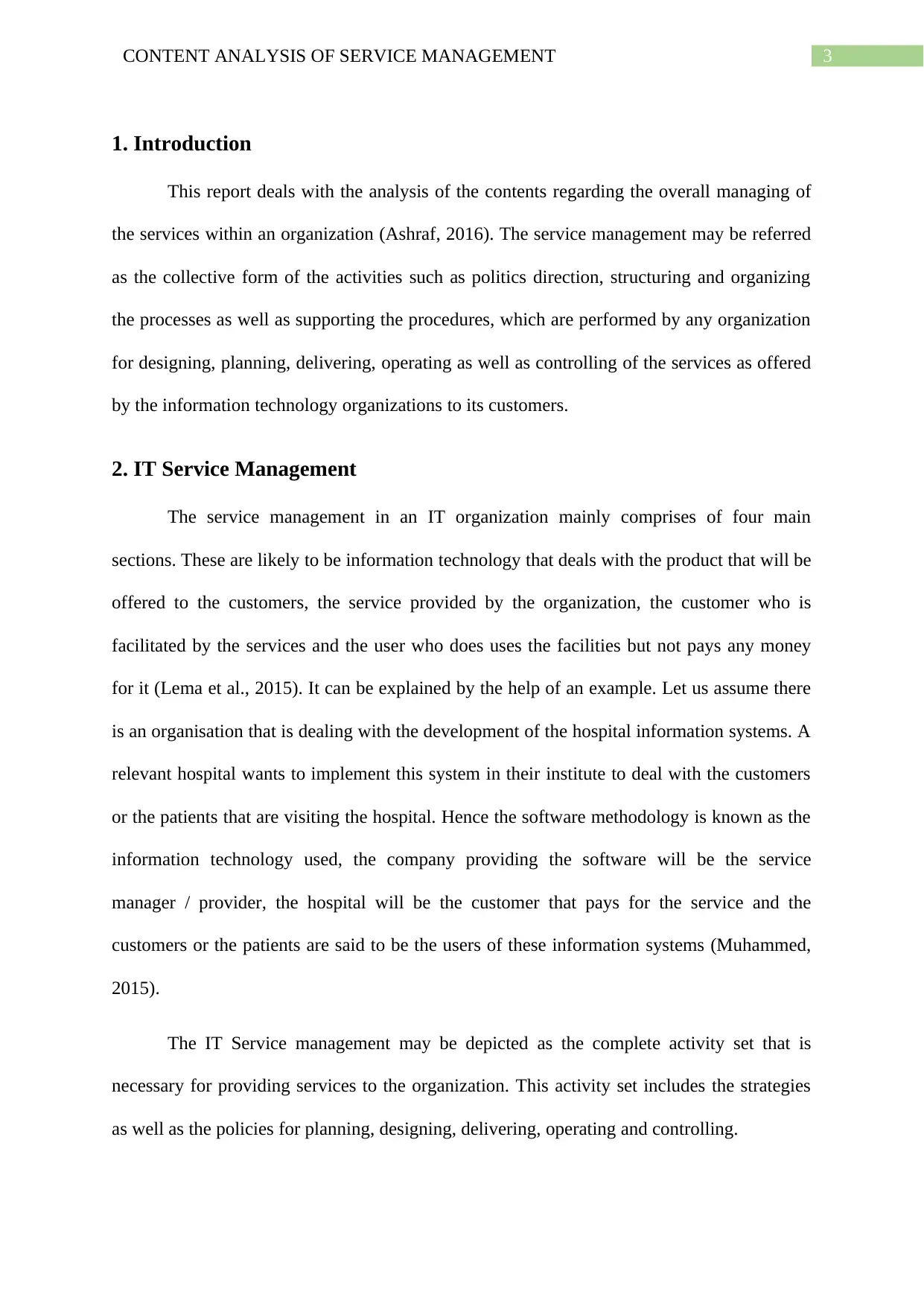
3CONTENT ANALYSIS OF SERVICE MANAGEMENT
1. Introduction
This report deals with the analysis of the contents regarding the overall managing of
the services within an organization (Ashraf, 2016). The service management may be referred
as the collective form of the activities such as politics direction, structuring and organizing
the processes as well as supporting the procedures, which are performed by any organization
for designing, planning, delivering, operating as well as controlling of the services as offered
by the information technology organizations to its customers.
2. IT Service Management
The service management in an IT organization mainly comprises of four main
sections. These are likely to be information technology that deals with the product that will be
offered to the customers, the service provided by the organization, the customer who is
facilitated by the services and the user who does uses the facilities but not pays any money
for it (Lema et al., 2015). It can be explained by the help of an example. Let us assume there
is an organisation that is dealing with the development of the hospital information systems. A
relevant hospital wants to implement this system in their institute to deal with the customers
or the patients that are visiting the hospital. Hence the software methodology is known as the
information technology used, the company providing the software will be the service
manager / provider, the hospital will be the customer that pays for the service and the
customers or the patients are said to be the users of these information systems (Muhammed,
2015).
The IT Service management may be depicted as the complete activity set that is
necessary for providing services to the organization. This activity set includes the strategies
as well as the policies for planning, designing, delivering, operating and controlling.
1. Introduction
This report deals with the analysis of the contents regarding the overall managing of
the services within an organization (Ashraf, 2016). The service management may be referred
as the collective form of the activities such as politics direction, structuring and organizing
the processes as well as supporting the procedures, which are performed by any organization
for designing, planning, delivering, operating as well as controlling of the services as offered
by the information technology organizations to its customers.
2. IT Service Management
The service management in an IT organization mainly comprises of four main
sections. These are likely to be information technology that deals with the product that will be
offered to the customers, the service provided by the organization, the customer who is
facilitated by the services and the user who does uses the facilities but not pays any money
for it (Lema et al., 2015). It can be explained by the help of an example. Let us assume there
is an organisation that is dealing with the development of the hospital information systems. A
relevant hospital wants to implement this system in their institute to deal with the customers
or the patients that are visiting the hospital. Hence the software methodology is known as the
information technology used, the company providing the software will be the service
manager / provider, the hospital will be the customer that pays for the service and the
customers or the patients are said to be the users of these information systems (Muhammed,
2015).
The IT Service management may be depicted as the complete activity set that is
necessary for providing services to the organization. This activity set includes the strategies
as well as the policies for planning, designing, delivering, operating and controlling.
Paraphrase This Document
Need a fresh take? Get an instant paraphrase of this document with our AI Paraphraser
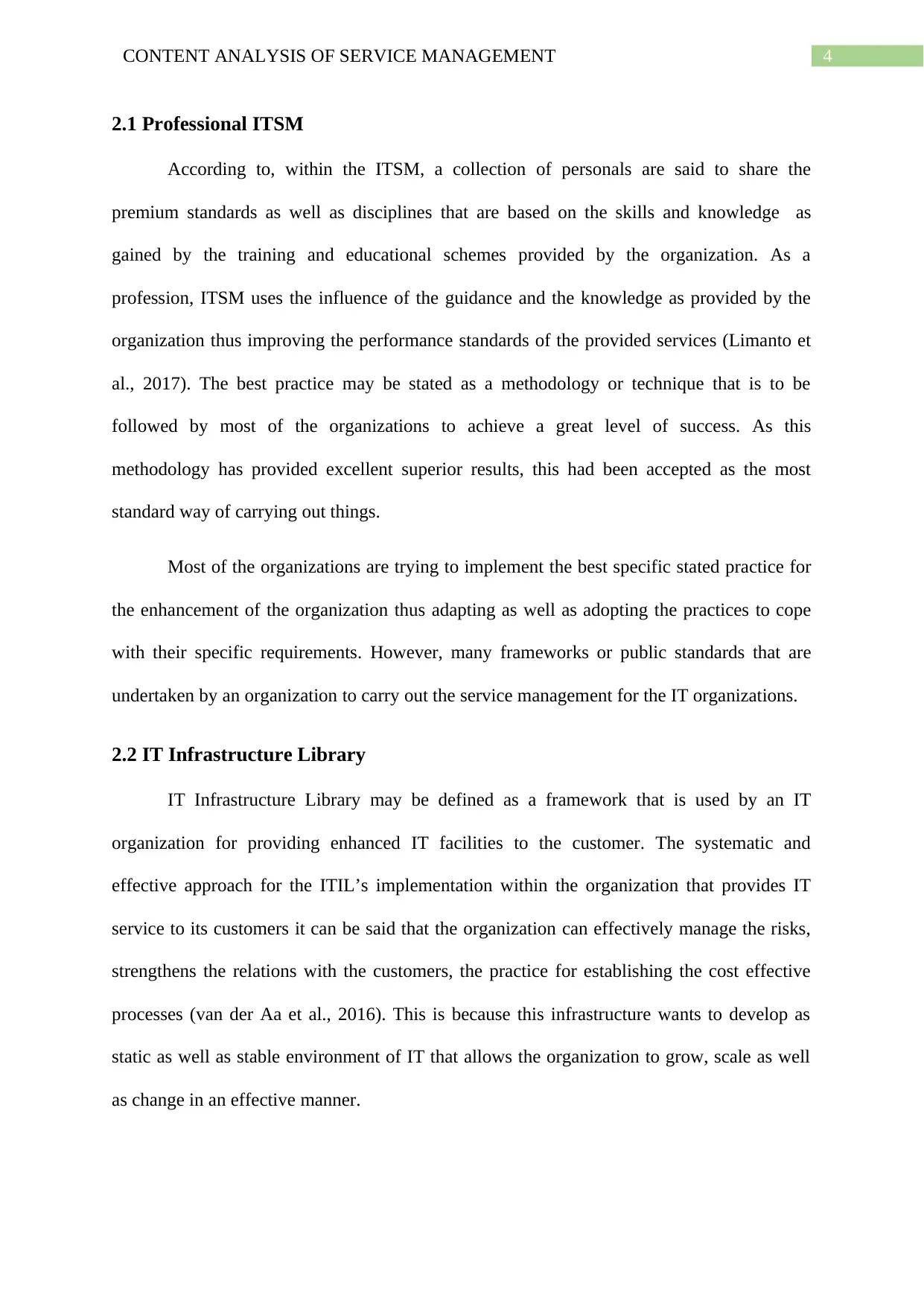
4CONTENT ANALYSIS OF SERVICE MANAGEMENT
2.1 Professional ITSM
According to, within the ITSM, a collection of personals are said to share the
premium standards as well as disciplines that are based on the skills and knowledge as
gained by the training and educational schemes provided by the organization. As a
profession, ITSM uses the influence of the guidance and the knowledge as provided by the
organization thus improving the performance standards of the provided services (Limanto et
al., 2017). The best practice may be stated as a methodology or technique that is to be
followed by most of the organizations to achieve a great level of success. As this
methodology has provided excellent superior results, this had been accepted as the most
standard way of carrying out things.
Most of the organizations are trying to implement the best specific stated practice for
the enhancement of the organization thus adapting as well as adopting the practices to cope
with their specific requirements. However, many frameworks or public standards that are
undertaken by an organization to carry out the service management for the IT organizations.
2.2 IT Infrastructure Library
IT Infrastructure Library may be defined as a framework that is used by an IT
organization for providing enhanced IT facilities to the customer. The systematic and
effective approach for the ITIL’s implementation within the organization that provides IT
service to its customers it can be said that the organization can effectively manage the risks,
strengthens the relations with the customers, the practice for establishing the cost effective
processes (van der Aa et al., 2016). This is because this infrastructure wants to develop as
static as well as stable environment of IT that allows the organization to grow, scale as well
as change in an effective manner.
2.1 Professional ITSM
According to, within the ITSM, a collection of personals are said to share the
premium standards as well as disciplines that are based on the skills and knowledge as
gained by the training and educational schemes provided by the organization. As a
profession, ITSM uses the influence of the guidance and the knowledge as provided by the
organization thus improving the performance standards of the provided services (Limanto et
al., 2017). The best practice may be stated as a methodology or technique that is to be
followed by most of the organizations to achieve a great level of success. As this
methodology has provided excellent superior results, this had been accepted as the most
standard way of carrying out things.
Most of the organizations are trying to implement the best specific stated practice for
the enhancement of the organization thus adapting as well as adopting the practices to cope
with their specific requirements. However, many frameworks or public standards that are
undertaken by an organization to carry out the service management for the IT organizations.
2.2 IT Infrastructure Library
IT Infrastructure Library may be defined as a framework that is used by an IT
organization for providing enhanced IT facilities to the customer. The systematic and
effective approach for the ITIL’s implementation within the organization that provides IT
service to its customers it can be said that the organization can effectively manage the risks,
strengthens the relations with the customers, the practice for establishing the cost effective
processes (van der Aa et al., 2016). This is because this infrastructure wants to develop as
static as well as stable environment of IT that allows the organization to grow, scale as well
as change in an effective manner.
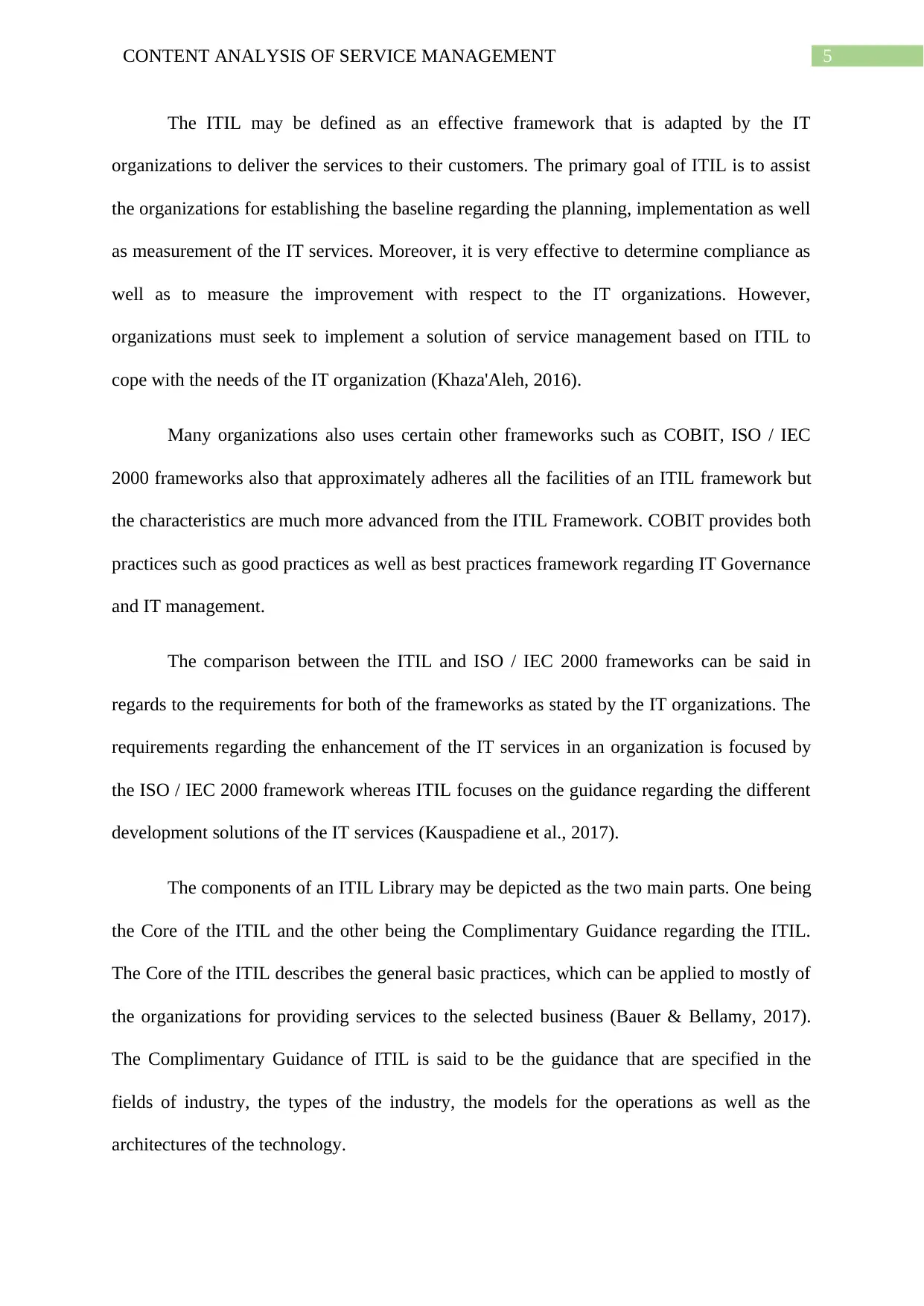
5CONTENT ANALYSIS OF SERVICE MANAGEMENT
The ITIL may be defined as an effective framework that is adapted by the IT
organizations to deliver the services to their customers. The primary goal of ITIL is to assist
the organizations for establishing the baseline regarding the planning, implementation as well
as measurement of the IT services. Moreover, it is very effective to determine compliance as
well as to measure the improvement with respect to the IT organizations. However,
organizations must seek to implement a solution of service management based on ITIL to
cope with the needs of the IT organization (Khaza'Aleh, 2016).
Many organizations also uses certain other frameworks such as COBIT, ISO / IEC
2000 frameworks also that approximately adheres all the facilities of an ITIL framework but
the characteristics are much more advanced from the ITIL Framework. COBIT provides both
practices such as good practices as well as best practices framework regarding IT Governance
and IT management.
The comparison between the ITIL and ISO / IEC 2000 frameworks can be said in
regards to the requirements for both of the frameworks as stated by the IT organizations. The
requirements regarding the enhancement of the IT services in an organization is focused by
the ISO / IEC 2000 framework whereas ITIL focuses on the guidance regarding the different
development solutions of the IT services (Kauspadiene et al., 2017).
The components of an ITIL Library may be depicted as the two main parts. One being
the Core of the ITIL and the other being the Complimentary Guidance regarding the ITIL.
The Core of the ITIL describes the general basic practices, which can be applied to mostly of
the organizations for providing services to the selected business (Bauer & Bellamy, 2017).
The Complimentary Guidance of ITIL is said to be the guidance that are specified in the
fields of industry, the types of the industry, the models for the operations as well as the
architectures of the technology.
The ITIL may be defined as an effective framework that is adapted by the IT
organizations to deliver the services to their customers. The primary goal of ITIL is to assist
the organizations for establishing the baseline regarding the planning, implementation as well
as measurement of the IT services. Moreover, it is very effective to determine compliance as
well as to measure the improvement with respect to the IT organizations. However,
organizations must seek to implement a solution of service management based on ITIL to
cope with the needs of the IT organization (Khaza'Aleh, 2016).
Many organizations also uses certain other frameworks such as COBIT, ISO / IEC
2000 frameworks also that approximately adheres all the facilities of an ITIL framework but
the characteristics are much more advanced from the ITIL Framework. COBIT provides both
practices such as good practices as well as best practices framework regarding IT Governance
and IT management.
The comparison between the ITIL and ISO / IEC 2000 frameworks can be said in
regards to the requirements for both of the frameworks as stated by the IT organizations. The
requirements regarding the enhancement of the IT services in an organization is focused by
the ISO / IEC 2000 framework whereas ITIL focuses on the guidance regarding the different
development solutions of the IT services (Kauspadiene et al., 2017).
The components of an ITIL Library may be depicted as the two main parts. One being
the Core of the ITIL and the other being the Complimentary Guidance regarding the ITIL.
The Core of the ITIL describes the general basic practices, which can be applied to mostly of
the organizations for providing services to the selected business (Bauer & Bellamy, 2017).
The Complimentary Guidance of ITIL is said to be the guidance that are specified in the
fields of industry, the types of the industry, the models for the operations as well as the
architectures of the technology.
⊘ This is a preview!⊘
Do you want full access?
Subscribe today to unlock all pages.

Trusted by 1+ million students worldwide
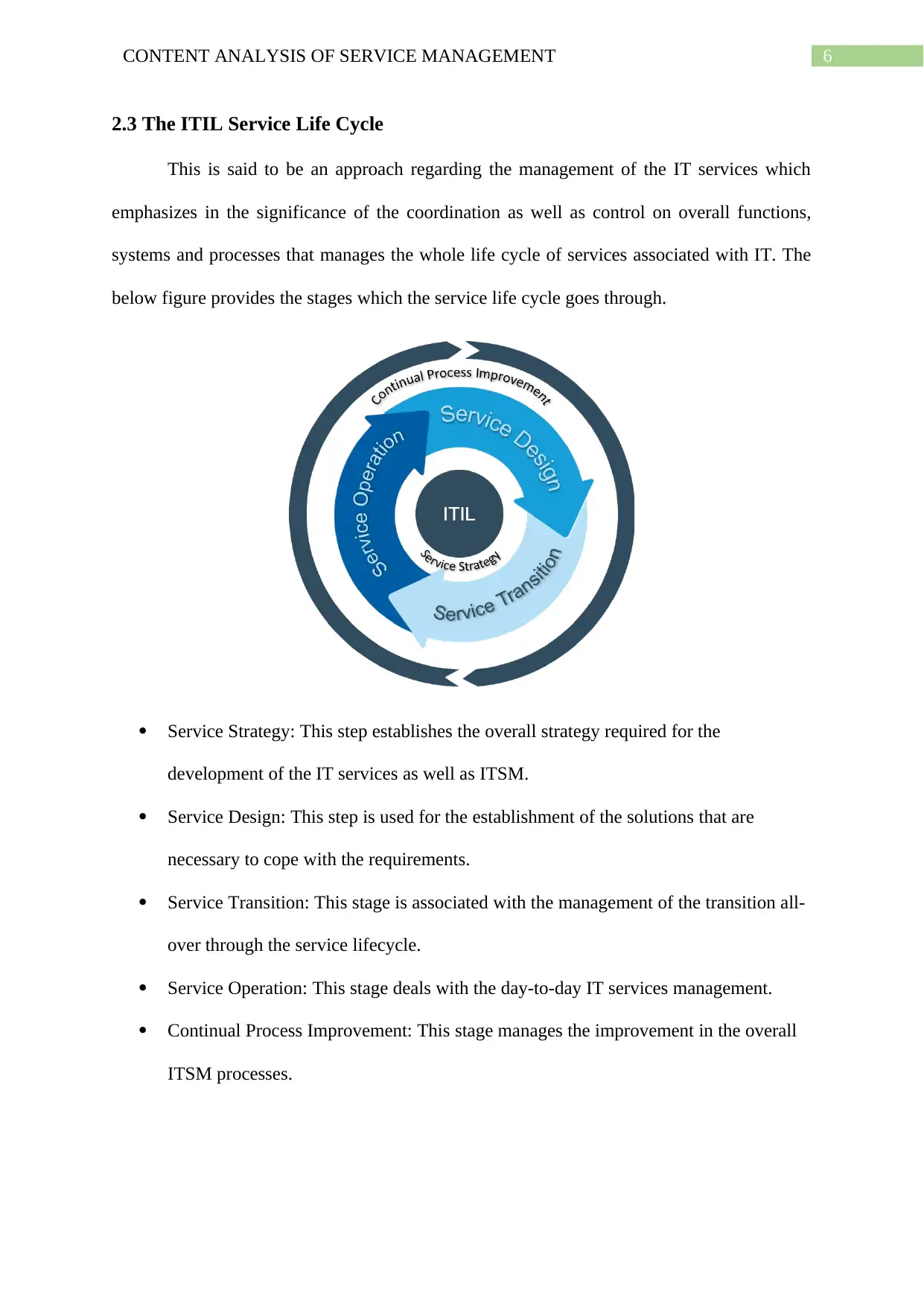
6CONTENT ANALYSIS OF SERVICE MANAGEMENT
2.3 The ITIL Service Life Cycle
This is said to be an approach regarding the management of the IT services which
emphasizes in the significance of the coordination as well as control on overall functions,
systems and processes that manages the whole life cycle of services associated with IT. The
below figure provides the stages which the service life cycle goes through.
Service Strategy: This step establishes the overall strategy required for the
development of the IT services as well as ITSM.
Service Design: This step is used for the establishment of the solutions that are
necessary to cope with the requirements.
Service Transition: This stage is associated with the management of the transition all-
over through the service lifecycle.
Service Operation: This stage deals with the day-to-day IT services management.
Continual Process Improvement: This stage manages the improvement in the overall
ITSM processes.
2.3 The ITIL Service Life Cycle
This is said to be an approach regarding the management of the IT services which
emphasizes in the significance of the coordination as well as control on overall functions,
systems and processes that manages the whole life cycle of services associated with IT. The
below figure provides the stages which the service life cycle goes through.
Service Strategy: This step establishes the overall strategy required for the
development of the IT services as well as ITSM.
Service Design: This step is used for the establishment of the solutions that are
necessary to cope with the requirements.
Service Transition: This stage is associated with the management of the transition all-
over through the service lifecycle.
Service Operation: This stage deals with the day-to-day IT services management.
Continual Process Improvement: This stage manages the improvement in the overall
ITSM processes.
Paraphrase This Document
Need a fresh take? Get an instant paraphrase of this document with our AI Paraphraser
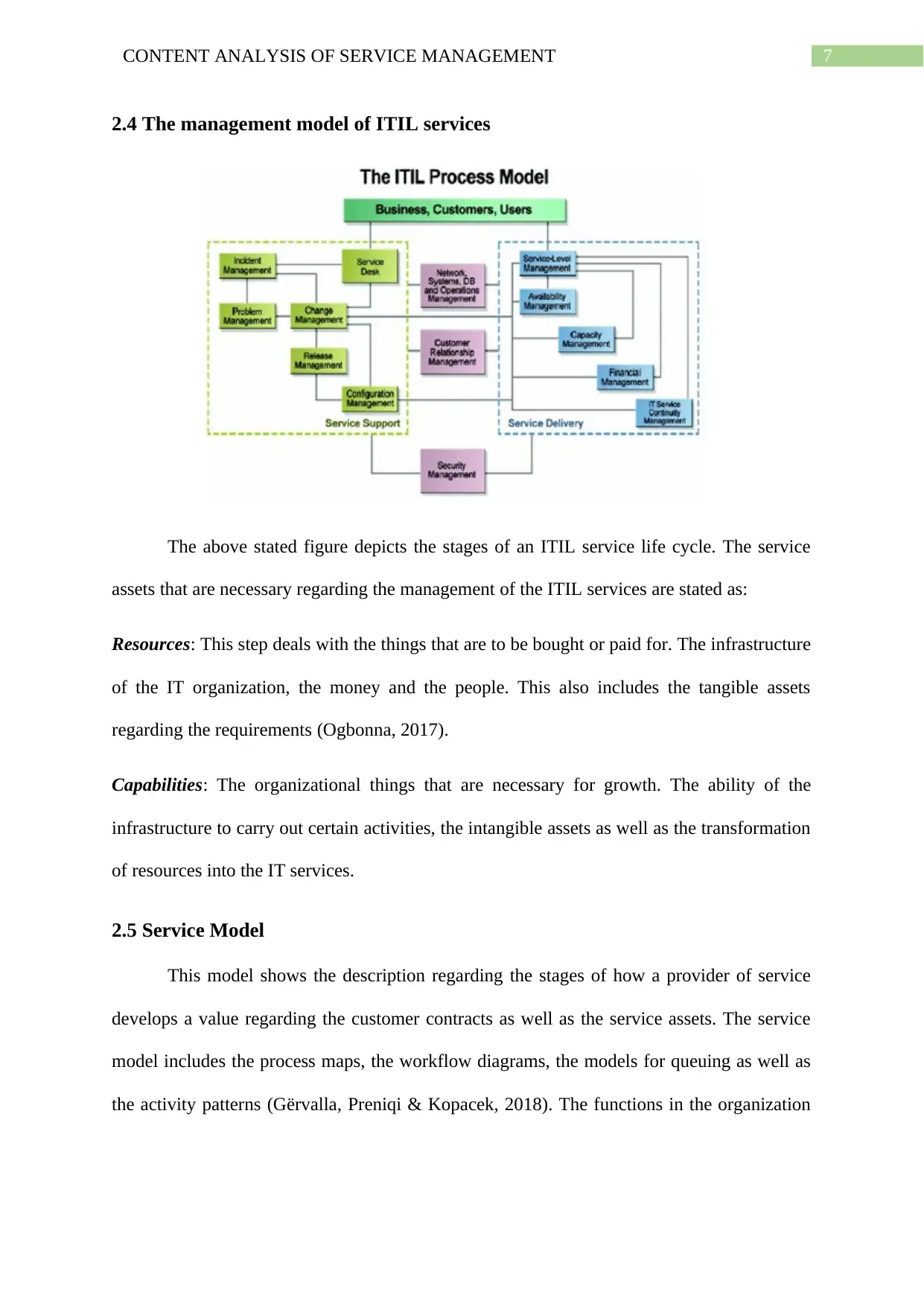
7CONTENT ANALYSIS OF SERVICE MANAGEMENT
2.4 The management model of ITIL services
The above stated figure depicts the stages of an ITIL service life cycle. The service
assets that are necessary regarding the management of the ITIL services are stated as:
Resources: This step deals with the things that are to be bought or paid for. The infrastructure
of the IT organization, the money and the people. This also includes the tangible assets
regarding the requirements (Ogbonna, 2017).
Capabilities: The organizational things that are necessary for growth. The ability of the
infrastructure to carry out certain activities, the intangible assets as well as the transformation
of resources into the IT services.
2.5 Service Model
This model shows the description regarding the stages of how a provider of service
develops a value regarding the customer contracts as well as the service assets. The service
model includes the process maps, the workflow diagrams, the models for queuing as well as
the activity patterns (Gërvalla, Preniqi & Kopacek, 2018). The functions in the organization
2.4 The management model of ITIL services
The above stated figure depicts the stages of an ITIL service life cycle. The service
assets that are necessary regarding the management of the ITIL services are stated as:
Resources: This step deals with the things that are to be bought or paid for. The infrastructure
of the IT organization, the money and the people. This also includes the tangible assets
regarding the requirements (Ogbonna, 2017).
Capabilities: The organizational things that are necessary for growth. The ability of the
infrastructure to carry out certain activities, the intangible assets as well as the transformation
of resources into the IT services.
2.5 Service Model
This model shows the description regarding the stages of how a provider of service
develops a value regarding the customer contracts as well as the service assets. The service
model includes the process maps, the workflow diagrams, the models for queuing as well as
the activity patterns (Gërvalla, Preniqi & Kopacek, 2018). The functions in the organization
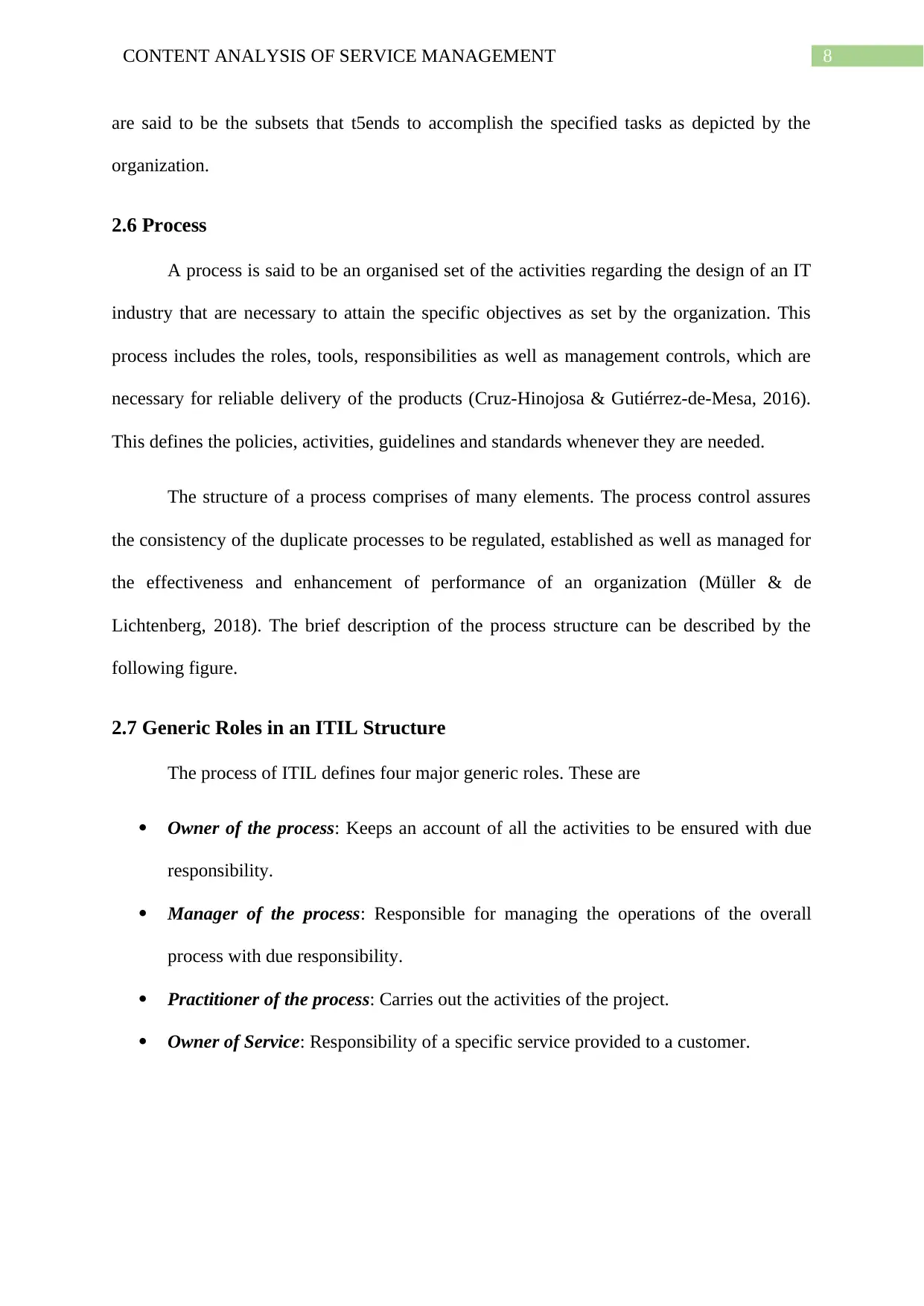
8CONTENT ANALYSIS OF SERVICE MANAGEMENT
are said to be the subsets that t5ends to accomplish the specified tasks as depicted by the
organization.
2.6 Process
A process is said to be an organised set of the activities regarding the design of an IT
industry that are necessary to attain the specific objectives as set by the organization. This
process includes the roles, tools, responsibilities as well as management controls, which are
necessary for reliable delivery of the products (Cruz-Hinojosa & Gutiérrez-de-Mesa, 2016).
This defines the policies, activities, guidelines and standards whenever they are needed.
The structure of a process comprises of many elements. The process control assures
the consistency of the duplicate processes to be regulated, established as well as managed for
the effectiveness and enhancement of performance of an organization (Müller & de
Lichtenberg, 2018). The brief description of the process structure can be described by the
following figure.
2.7 Generic Roles in an ITIL Structure
The process of ITIL defines four major generic roles. These are
Owner of the process: Keeps an account of all the activities to be ensured with due
responsibility.
Manager of the process: Responsible for managing the operations of the overall
process with due responsibility.
Practitioner of the process: Carries out the activities of the project.
Owner of Service: Responsibility of a specific service provided to a customer.
are said to be the subsets that t5ends to accomplish the specified tasks as depicted by the
organization.
2.6 Process
A process is said to be an organised set of the activities regarding the design of an IT
industry that are necessary to attain the specific objectives as set by the organization. This
process includes the roles, tools, responsibilities as well as management controls, which are
necessary for reliable delivery of the products (Cruz-Hinojosa & Gutiérrez-de-Mesa, 2016).
This defines the policies, activities, guidelines and standards whenever they are needed.
The structure of a process comprises of many elements. The process control assures
the consistency of the duplicate processes to be regulated, established as well as managed for
the effectiveness and enhancement of performance of an organization (Müller & de
Lichtenberg, 2018). The brief description of the process structure can be described by the
following figure.
2.7 Generic Roles in an ITIL Structure
The process of ITIL defines four major generic roles. These are
Owner of the process: Keeps an account of all the activities to be ensured with due
responsibility.
Manager of the process: Responsible for managing the operations of the overall
process with due responsibility.
Practitioner of the process: Carries out the activities of the project.
Owner of Service: Responsibility of a specific service provided to a customer.
⊘ This is a preview!⊘
Do you want full access?
Subscribe today to unlock all pages.

Trusted by 1+ million students worldwide
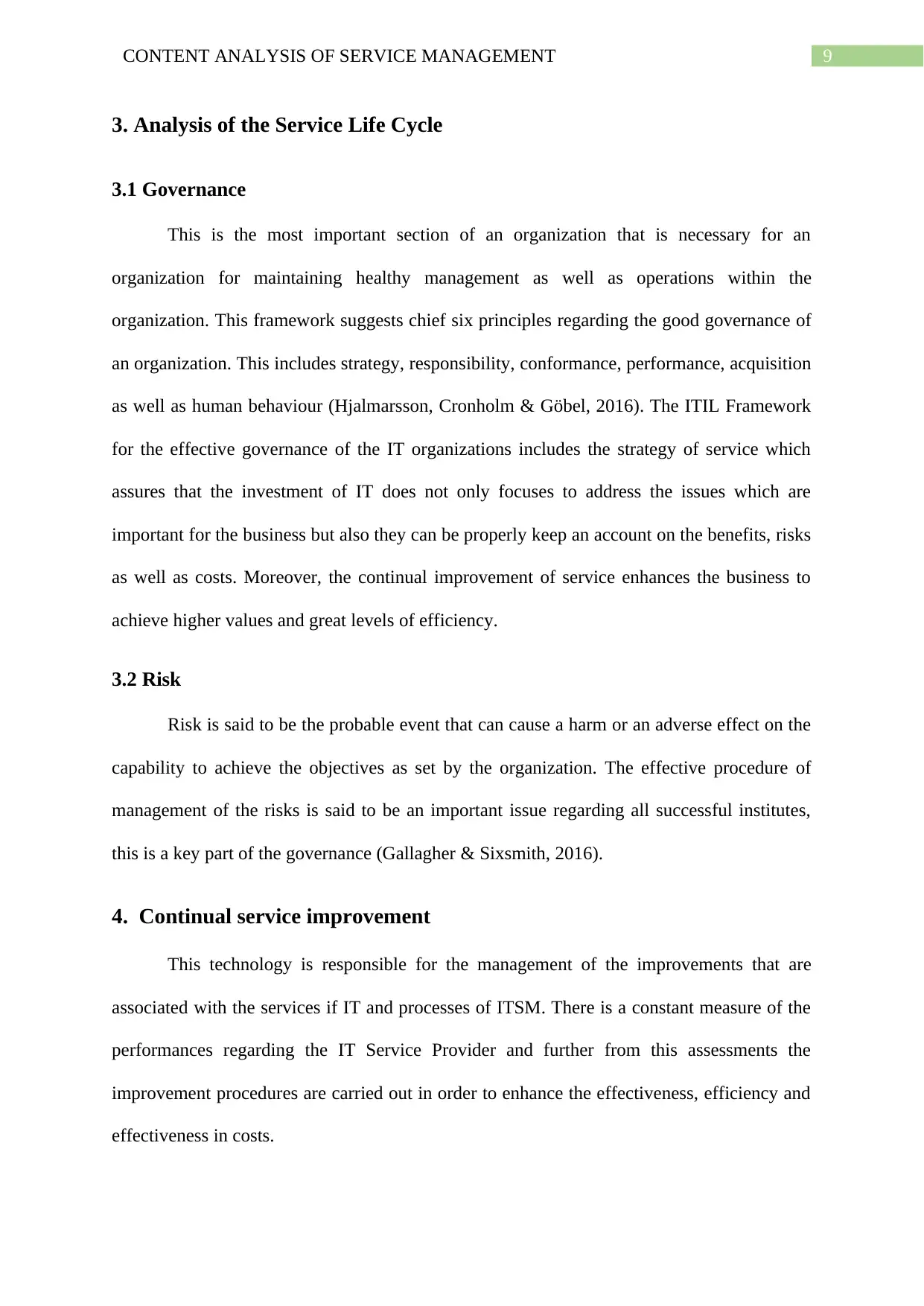
9CONTENT ANALYSIS OF SERVICE MANAGEMENT
3. Analysis of the Service Life Cycle
3.1 Governance
This is the most important section of an organization that is necessary for an
organization for maintaining healthy management as well as operations within the
organization. This framework suggests chief six principles regarding the good governance of
an organization. This includes strategy, responsibility, conformance, performance, acquisition
as well as human behaviour (Hjalmarsson, Cronholm & Göbel, 2016). The ITIL Framework
for the effective governance of the IT organizations includes the strategy of service which
assures that the investment of IT does not only focuses to address the issues which are
important for the business but also they can be properly keep an account on the benefits, risks
as well as costs. Moreover, the continual improvement of service enhances the business to
achieve higher values and great levels of efficiency.
3.2 Risk
Risk is said to be the probable event that can cause a harm or an adverse effect on the
capability to achieve the objectives as set by the organization. The effective procedure of
management of the risks is said to be an important issue regarding all successful institutes,
this is a key part of the governance (Gallagher & Sixsmith, 2016).
4. Continual service improvement
This technology is responsible for the management of the improvements that are
associated with the services if IT and processes of ITSM. There is a constant measure of the
performances regarding the IT Service Provider and further from this assessments the
improvement procedures are carried out in order to enhance the effectiveness, efficiency and
effectiveness in costs.
3. Analysis of the Service Life Cycle
3.1 Governance
This is the most important section of an organization that is necessary for an
organization for maintaining healthy management as well as operations within the
organization. This framework suggests chief six principles regarding the good governance of
an organization. This includes strategy, responsibility, conformance, performance, acquisition
as well as human behaviour (Hjalmarsson, Cronholm & Göbel, 2016). The ITIL Framework
for the effective governance of the IT organizations includes the strategy of service which
assures that the investment of IT does not only focuses to address the issues which are
important for the business but also they can be properly keep an account on the benefits, risks
as well as costs. Moreover, the continual improvement of service enhances the business to
achieve higher values and great levels of efficiency.
3.2 Risk
Risk is said to be the probable event that can cause a harm or an adverse effect on the
capability to achieve the objectives as set by the organization. The effective procedure of
management of the risks is said to be an important issue regarding all successful institutes,
this is a key part of the governance (Gallagher & Sixsmith, 2016).
4. Continual service improvement
This technology is responsible for the management of the improvements that are
associated with the services if IT and processes of ITSM. There is a constant measure of the
performances regarding the IT Service Provider and further from this assessments the
improvement procedures are carried out in order to enhance the effectiveness, efficiency and
effectiveness in costs.
Paraphrase This Document
Need a fresh take? Get an instant paraphrase of this document with our AI Paraphraser
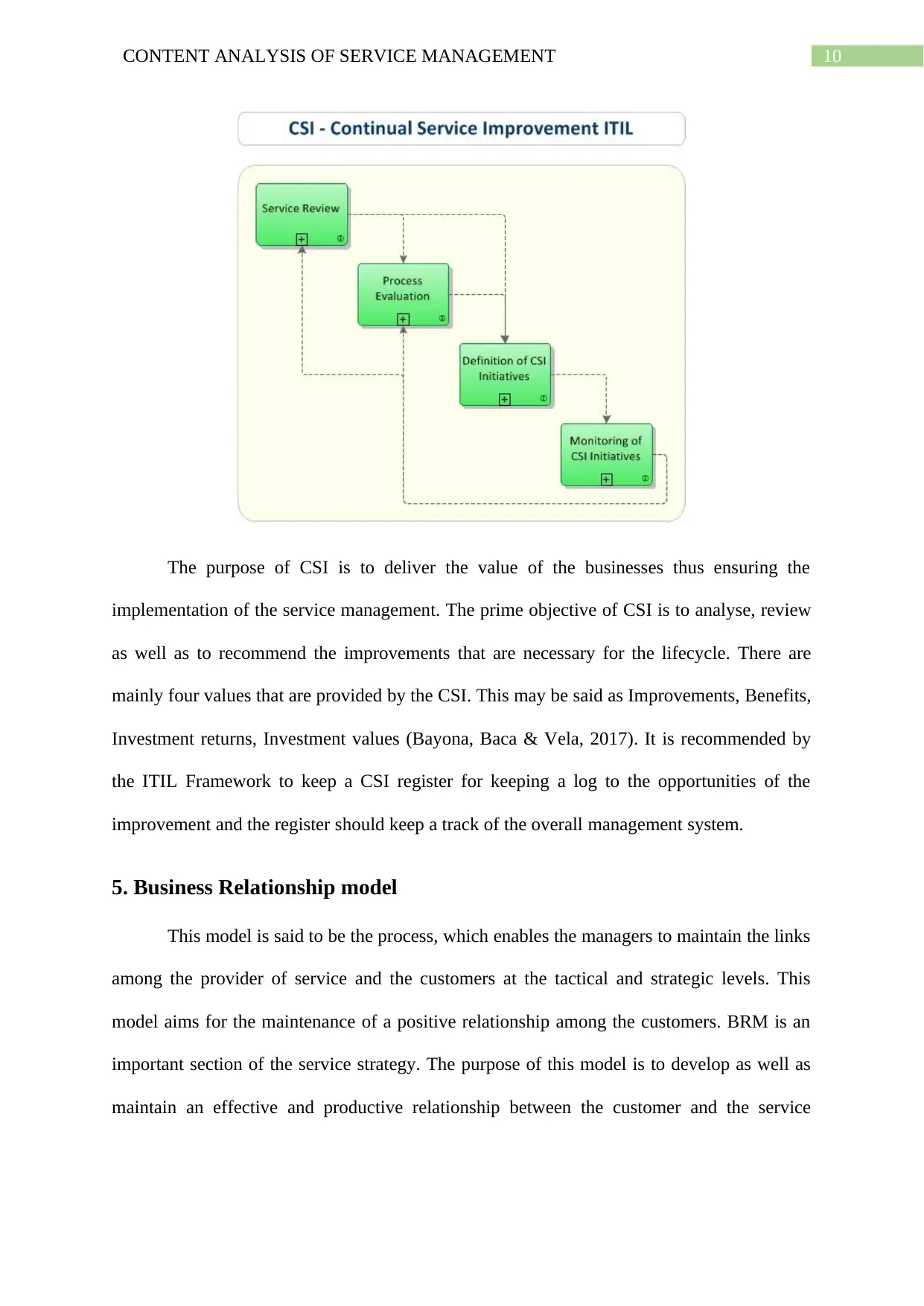
10CONTENT ANALYSIS OF SERVICE MANAGEMENT
The purpose of CSI is to deliver the value of the businesses thus ensuring the
implementation of the service management. The prime objective of CSI is to analyse, review
as well as to recommend the improvements that are necessary for the lifecycle. There are
mainly four values that are provided by the CSI. This may be said as Improvements, Benefits,
Investment returns, Investment values (Bayona, Baca & Vela, 2017). It is recommended by
the ITIL Framework to keep a CSI register for keeping a log to the opportunities of the
improvement and the register should keep a track of the overall management system.
5. Business Relationship model
This model is said to be the process, which enables the managers to maintain the links
among the provider of service and the customers at the tactical and strategic levels. This
model aims for the maintenance of a positive relationship among the customers. BRM is an
important section of the service strategy. The purpose of this model is to develop as well as
maintain an effective and productive relationship between the customer and the service
The purpose of CSI is to deliver the value of the businesses thus ensuring the
implementation of the service management. The prime objective of CSI is to analyse, review
as well as to recommend the improvements that are necessary for the lifecycle. There are
mainly four values that are provided by the CSI. This may be said as Improvements, Benefits,
Investment returns, Investment values (Bayona, Baca & Vela, 2017). It is recommended by
the ITIL Framework to keep a CSI register for keeping a log to the opportunities of the
improvement and the register should keep a track of the overall management system.
5. Business Relationship model
This model is said to be the process, which enables the managers to maintain the links
among the provider of service and the customers at the tactical and strategic levels. This
model aims for the maintenance of a positive relationship among the customers. BRM is an
important section of the service strategy. The purpose of this model is to develop as well as
maintain an effective and productive relationship between the customer and the service
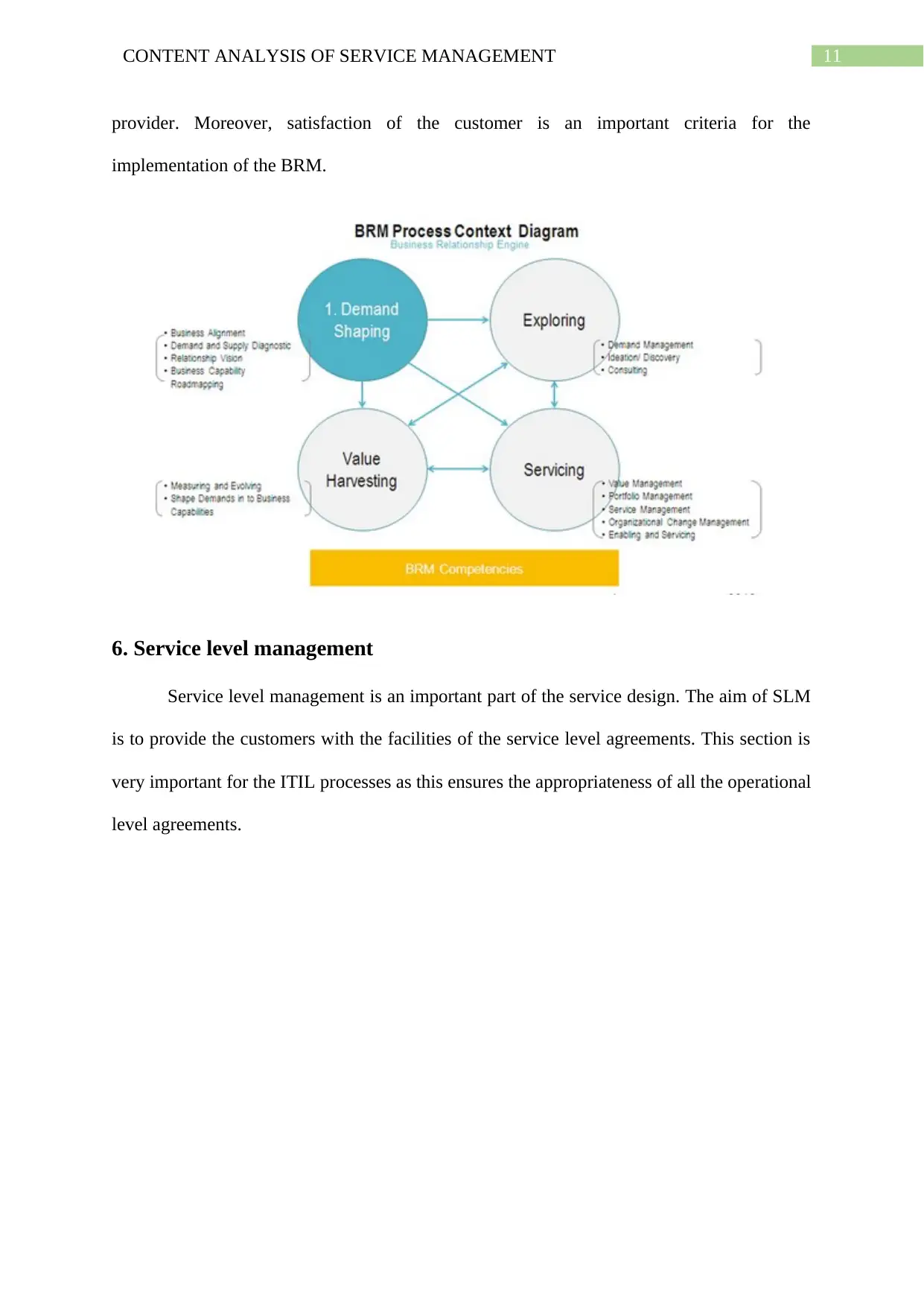
11CONTENT ANALYSIS OF SERVICE MANAGEMENT
provider. Moreover, satisfaction of the customer is an important criteria for the
implementation of the BRM.
6. Service level management
Service level management is an important part of the service design. The aim of SLM
is to provide the customers with the facilities of the service level agreements. This section is
very important for the ITIL processes as this ensures the appropriateness of all the operational
level agreements.
provider. Moreover, satisfaction of the customer is an important criteria for the
implementation of the BRM.
6. Service level management
Service level management is an important part of the service design. The aim of SLM
is to provide the customers with the facilities of the service level agreements. This section is
very important for the ITIL processes as this ensures the appropriateness of all the operational
level agreements.
⊘ This is a preview!⊘
Do you want full access?
Subscribe today to unlock all pages.

Trusted by 1+ million students worldwide
1 out of 21
Related Documents
Your All-in-One AI-Powered Toolkit for Academic Success.
+13062052269
info@desklib.com
Available 24*7 on WhatsApp / Email
![[object Object]](/_next/static/media/star-bottom.7253800d.svg)
Unlock your academic potential
Copyright © 2020–2025 A2Z Services. All Rights Reserved. Developed and managed by ZUCOL.





